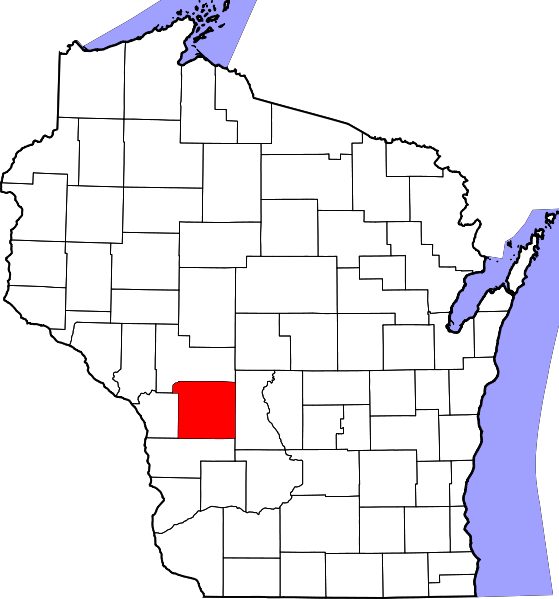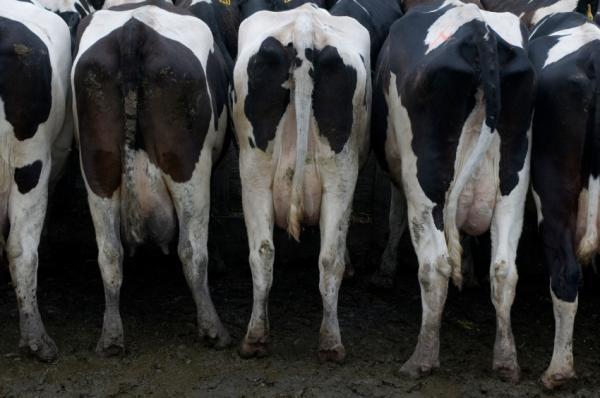12/8/08 What Happened in Monroe County? AND When it comes to manure digesters, we say ON WISCONSIN!
 Board of adjustment decision reversed in consolidated case concerning Town of Wells
Board of adjustment decision reversed in consolidated case concerning Town of Wells
December 4, 2008
by Pat Mulvaney in The Sparta Herald
Plans of a Chicago-based wind developer to erect over 60 wind turbines in the area may have been derailed by a ruling in Monroe County Circuit Court last week.
In a decision released Wednesday, Judge Michael McAlpine upheld the actions of the towns of Wilton and Ridgeville, which vetoed conditional use permits (CUPs) issued to the wind developer. He also reversed a ruling of the Monroe County Board of Adjustment (BOA), effectively canceling out a similar CUP in the Town of Wells.
The Monroe County Zoning Committee issued the CUPs last year to Invenergy, which is doing business locally as Summit Ridge Energy LLC. The permits would have allowed the company to erect 40-story high wind turbines within Ridgeville and Wilton townships.
Shortly after the townships' vetoes of the CUPs last spring, Invenergy filed a lawsuit, claiming the vetoes were illegal under a state statute that disallows restrictions on wind energy facilities unless for reasons of public health and safety.
However, when Ridgeville and Wilton issued their vetoes, a right given them by county ordinance, one of their arguments was the CUPs were incomplete. William Semann and Myron Brueggeman made the same argument in their case in the Town of Wells.
Among their objections was the inadequacy of a map required as part of the CUP. In particular, the omission of the locations of buried transmission lines which would carry electricity from the turbines to a substation.
Invenergy, the zoning committee and BOA had argued the transmission lines were not accessory structures, and therefore not required to be included on the project map.
In his decision, McAlpine disagreed, saying that lack of disclosure gave the towns the right to veto the CUPs under the health and safety provision provided by state law.
"Without all necessary information on the proposed project being available, neither town would be fully equipped to make such an important assessment," wrote McAlpine.
"The notion those integral parts (transmission lines) of the proposed wind energy facility lying beneath the surface need not be disclosed on the required application map, I believe to be contrary to both the public's right to access, investigate, and participate, as well as the (zoning) committee's responsibility to thoroughly evaluate before acting."
McAlpine rejected the town's assertions that the zoning committee acted with bias toward Invenergy. He also said he found no merit to the argument that Semann and Brueggeman didn't receive a complete and fair appeal before the BOA.
"I am satisfied, absent the application mapping omissions, that the BOA's decision to affirm the award of the Town of Wells CUP would have withstood the court's...review," he wrote.
Semann and Brueggeman filed suit in Monroe County Circuit Court in May, claiming the zoning committee's action will adversely affect their health and safety and interfere with the use and value of their property including their air space.
Semann runs a farm operation on a few hundred acres between Summit Ridge and St. Mary's Ridge, while Brueggeman, a retired airline pilot from Chicago, owns 300 acres of ridge top land nearby.
Brueggeman has plans to turn his property into a housing development with an airstrip, which he has already acquire a CUP from the county.
The action by the Town of Wells was reviewed by the Monroe County Board of Adjustment, which found in favor of the zoning committee, upholding the CUP.
In a related matter, last August the towns of Ridgeville and Wilton approved identical ordinances, calling for half-mile setbacks from residences or occupied structures, a 1,640-foot increase over setbacks dictated by the county's ordinance.
The greater setbacks are likely to drastically reduce the number of turbines that can be erected because of the close proximity of houses in the proposed project area.
Besides the half-mile setback from residences, the ordinances call for a 1,300-foot setback from property lines and stricter regulations covering noise, siting, decommissioning, inspection and application requirements.
Web link: http://www.spartanewspapers.com/headlines.html
NOTE FROM THE BPWI RESEARCH NERD: The following story is not about the cutest of Wisconsin's renewable energy options, but it's a Better Plan favorite! It's the only renewable energy option we know of that takes care of other environmental problems as it generates electricity.

Wisconsin boasts most manure-to-energy projects
When it comes to generating renewable energy, Wisconsin lacks the high winds of the Great Plains and the steady sunlight of Arizona, but it has one abundant resource few others can match - cow power.
Although renewable energy makes up only a fraction of the state's total energy mix, one area that's growing fast is systems that convert cow manure into electricity and heat.
At the Crave Brothers dairy farm and cheese factory in Waterloo, the farm's anaerobic digester - its cow power system - takes manure from the farm's 1,100 cows and converts it to electricity.
Rising demand for the company's specialty cheeses led to an expansion that will add a second digester and triple the amount of electricity the farm produces.
"They process their own milk, and the demand for the specialty cheeses they make has increased enough to justify an expansion," said Dan Nemke, general manager of Clear Horizons, which provides the digester.
Clear Horizons estimates it invested $4 million in the Waterloo system.
Wisconsin leads the country in anaerobic digesters with 19 projects. California is second, with 16.
"And we have 16 projects under contract right now set to go in, so we should be doubling the number of digesters in this state in the next year," said Don Wichert, director of renewable energy with the state Focus on Energy program.
Behind the surge in interest in homegrown energy is the recognition that what once was waste now has value. That can include anything from cheese whey to restaurant grease to cow manure.
Alternative energy push
Renewable energy experts expect activity to intensify, given the drive to boost alternative energy sources by state and federal policy-makers.
Several recommendations to boost renewable energy from waste - known as biogas - were suggested by the state's global warming task force and may be included in a package of proposals Gov. Jim Doyle submits to the Legislature next year.
President-elect Barack Obama has voiced support for global warming legislation and has said boosting alternative energy will be one of the ingredients of his economic stimulus package that he would like to see Congress enact in early 2009.
"We've got lots of projects that would be ready to go if the economics in some way were improved," said Richard Pieper, president of Pieper Power, the Milwaukee parent company of Clear Horizons. If the U.S. enacted legislation to reduce greenhouse gas emissions, the economics would improve and "we would have enough opportunity here to power 175,000 homes in Wisconsin," he said.
Clear Horizons is a unit of Pieper's mining equipment automation business and its wastewater technology business. The firm entered the renewable energy arena seeking ways to take its construction and automation know-how and adapt it to emerging energy technologies.
"At this point, it doesn't amount to anything. It's very modest. It's less than a percent, but we're a pretty good-sized company," Pieper said.
Cow power and other renewable energy projects could be a big piece of total sales in 12 to 24 months, he said.
But Wisconsin's leadership role in renewable energy is being challenged as other states deploy the digester systems, which help reduce waste runoff into streams and minimize odors.
At the moment, other states are more competitive than Wisconsin in attracting investment in the systems, either through special electricity rates, tax incentives or both. California, which supplanted Wisconsin as the biggest dairy state several years ago, could soon overtake the state in anaerobic digesters.
Renewable energy projects are more economical in other states, such as Vermont, where incentives such as the state's Cow Power program are more lucrative than what Wisconsin offers.
"We've got a bunch of opportunities in Wisconsin," Pieper said. "They're planned, but there's nothing going forward. The economics of the plants aren't where they need to be moving forward."
The price of power
GHD Inc., which opened its first digester system in 2001, now has more digesters installed in Wisconsin than any other company.
The Chilton firm has 30 systems operating in nearly a dozen states, with another 20 planned. In Wisconsin, 10 systems have been built with another five on tap.
"We came close to doubling our size this year," said Melissa VanOrnum, marketing manager at GHD.
Driving the increase: Utilities are paying more for electricity generated by the systems. Also, farmers are more confident in the anaerobic digester technology.
"When I started working for GHD in 2004, the first question that farmers asked was, 'Does it really work?' But for at least the last two years, they're not asking, 'Does it work?' They're asking, 'What's my payback?' " VanOrnum said.
Other companies also are seeing growth outside Wisconsin.
Microgy, which installed three systems in Wisconsin, is focusing on projects in Texas, Nebraska and California.
One of the challenges for Wisconsin is that the digesters make the most economic sense for large farms, Focus on Energy's Wichert said.
"The biggest farms that we had were the first ones that went in, and all these gigantic farms in California, Texas, Florida and New York are realizing they should be doing digestion, too."
The price of power also determines where a system will be installed, said Larry Krom, who manages biogas renewable-energy programs for Focus on Energy.
Power prices are steeper in states such as California and Vermont. When prices are higher, the rate small generators can collect from selling power to utilities is higher.
Several utilities have boosted their renewable rates in recent years, and Madison's Wisconsin Power & Light Co. will have the highest rate in the state beginning in January.
The utility is proposing to boost its rate by 50% to 9.24 cents per kilowatt in a case that's pending with state regulators.
Interest in new biogas projects is still active, Krom said.
"Over the next month or two, a whole bunch of them are going to come on," he said.
Although most of the projects in the state process cow manure, food businesses are getting into the act. In La Crosse, City Brewery and Gundersen Lutheran Medical Foundation set up a system using waste from the brewing process to create enough electricity to power 492 average Wisconsin homes, according to Focus on Energy.
As they watch to see whether more policies encouraging renewable energy will be implemented in Washington and Madison, those in the biogas industry see plenty of room for expansion in Wisconsin.
Wichert predicts a tenfold increase in the number of cow-power systems in the state, with digesters dotting the rural landscape.
"We still have a long way to go," Wichert said, noting Wisconsin has 250 farms with at least 500 cows each. "Those probably will all eventually have digesters," he said.